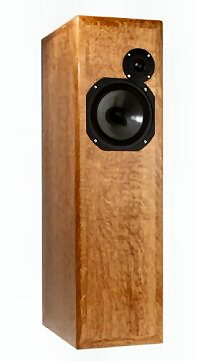KLS 9
THE DESIGN
To achieve reasonable power handling as well as deep bass
with real punch, an 8in. cone is called for. To maintain
quality above 2kHz, I chose a High Definition Aerogel
(HDA) driver from Audax, the HM210ZO. HDA is a composite
material comprising Kevlar and Carbon fibres, which
together form an extremely light yet rigid cone with
optimised internal damping. The tweeter I chose was the
tried and tested Audax TWO25MO. This fabric-dome device
reaches down far enough to meet the mid/bass unit at
around 3kHz and has sufficient sensitivity to make a good
match. With the HM210ZO, on paper a box volume of 2.6cu.
ft. (0.075 cubic metres) produces bass down to 36Hz
(-3dB), which is low. You will find our cabinet is, in
fact, 0.072 cubic metres, but lining the cabinet
internally with sound absorbent makes the cabinet appear
bigger as far as the drive unit is concerned. The cabinet
was proportioned so that a point half way between the
mid/bass and the tweeter would be 2ft. 6in. from the
floor - ear-height in a normal seat. The front was
deliberately kept narrow for best imaging. The reflex
port itself is not too critical, although to keep
distortion down, it must be made fairly large. In terms
of positioning, it should be placed close to the floor on
the rear baffle. Ideally the base should have floor
spikes fitted. The cabinet side panels would benefit from
bracing with 1in. dowel too, since this speaker produces
a lot of bass energy.
THE CROSSOVER
KLS9 turned out to require only a minimal crossover,
which makes it even easier to build and less expensive. I
found a first-order (-6dB/octave) low-pass filter was
sufficient, as it should be with a well-engineered
driver. The high-pass section for the tweeter was
calculated to make it flat in response terms and a close
phase match with the mid/bass unit.
And the final result? Frequency response was as I prefer
it, with a slow downward trend at high frequencies, no
crossover suck-out around 3kHz at all, and no phase
errors in this region to put in an off-axis dip. Keeping
the midrange flat like this ensures good detailing and
vocal projection. The crossover is so simple it can be
soldered directly onto the input terminal panel. We used
Solen audio-grade polypropylene capacitors along with a
ferrite-cored inductor for the lowest DCR.
![]()

Technical Data: |
|
| Nominal power handling | 80 W |
| Peak power handling | 120 W |
| Nominal impedance | 8 Ohm |
| Frequency response | 40 - 20000 Hz |
| Sensitivity (nominal) | 91 dB (1 W/1 m) |
| Crossover frequency | 2000 Hz |
| Cabinet type | Bassreflex |
| Net volume | 72 l |
| Height | 1000 mm |
| Width | 260 mm |
| Depth | 350 mm |